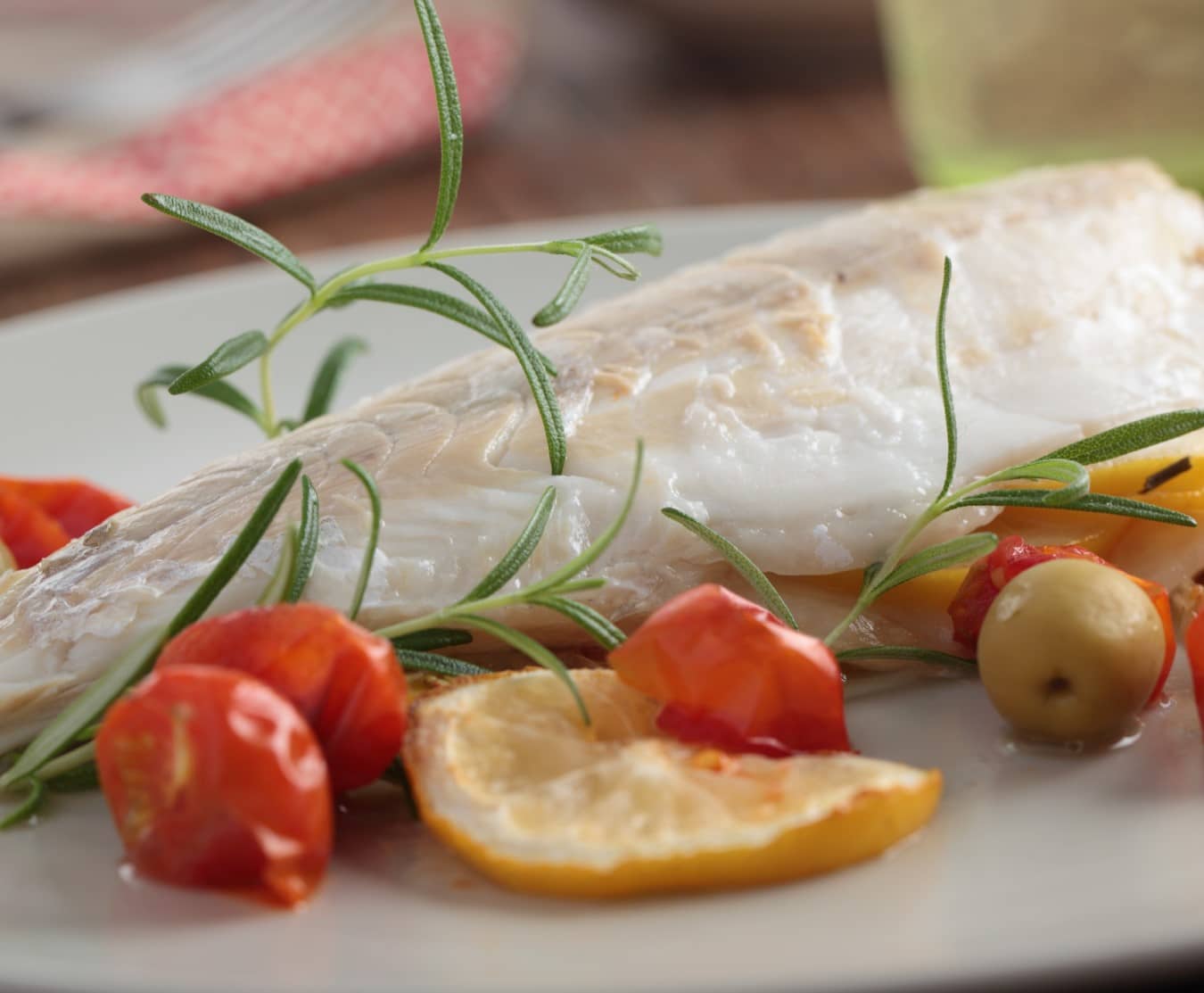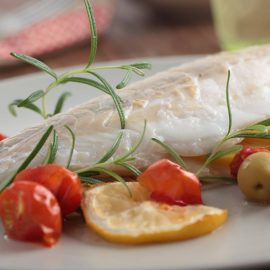
What is Stone Bass?
Most people had just learned what stone bass was because it was only ever used as a name for a relatively rare fish, wreckfish. The stone bass discussed here goes by the Latin name, Argyrosomus regius. Also known as meagre or corvina, it’s pretty rare in the wild and as good as unknown around UK coasts.
Wreckfish or Polyprion americanus is even rarer, but when it does turn up is sometimes known as stone bass, perhaps because the two species look vaguely similar. And both bear a passing resemblance to the far better-known and much more popular sea bass (Dicentratus labrax).
Cooking Stone Bass
Is stone bass tasty? It’s a low-fat fish, pleasant without being distinctive. It has lovely white muscle flakes quality and, of course, comes in gratifyingly large steaks, boneless when you buy them from us. It can be served raw with the bold flavours of Asian vinaigrette after marinating in juniper berries for 24 hours. And to add a bit of glamour to the dish, you can add a little caviar.
Fish like stone bass contain excellent cholesterol and protein, essential for blood vessel health and muscle growth. Moreover, it contains Omega-3 fatty acids that benefit brain and heart health.
This fish is rich in vitamin B6, niacin, calcium, and phosphorus, which are essential for forming red blood cells, bones, and metabolism.
A variety of preparations can be made with Stone Bass, which gets its name from the rock ledges and shipwrecks it inhabits all over the world.
With bold flavours like cayenne pepper, lemon, mustard or soy sauce, the Stone Bass Fillets are perfect for marinating. The best way to cook and eat this fish is to pan-fry it over medium heat for a few minutes using butter on each side to lock the flavours and the moisture in—best paired with a glass of wine.
Pan-Roasted Stone Bass
The dish is served with roasted cauliflower, black pudding, truffled chicken juices, and seaweed butter.
Ingredients
The main ingredients
- One large or medium stone bass (deboned, scaled, and filleted)
- Four Jerusalem artichokes (peeled, cleaned, then fried in duck fat for 30 minutes)
- 200 grams of wild mushrooms (washed and grit-free)
Sauce
- Three banana shallots (sliced lengthways)
- One thyme sprig
- Two cloves of garlic (peeled and crushed)
- Eight pieces of chicken wings (cut into pieces)
- Sherry vinegar, 150ml
- Madeira wine, 300 ml
- Dark chicken stock, 1 litre
- Morel mushroom, dried
Cauliflower puree
- Two medium-sized or one large cauliflower
- Unsalted butter, 150g
- Double cream, 150g
Back pudding balls
- Approximately 300 grams of black pudding
- One sprig of thyme (without the leaves)
- Two banana shallots (minced finely and roasted in duck fat, then cooled)
- Apple vinegar, 50ml
Seaweed butter
- Cream Fraiche 500g
- Double cream, 500g
- ½ Vanilla pod
- 300g of seaweed
For the coating
- Three eggs
- Whole milk, 200ml
- Flour 100g
- Panko breadcrumbs 200g
Method
Ensure that the bass is trimmed, scaled, deboned and scored (or have your local fishmonger do it).
Refresh seaweed by rinsing it three times thoroughly. Let dry at 95 degrees for an hour, then grind to a powder. To make butter, beat crème Fraiche with double cream for a few minutes, strain it through cheesecloth, squeeze out the buttermilk, and then store it. Once the remaining solids are seasoned with salt, seaweed powder, and a touch of vanilla, roll them up in a log and chill until firm.
You can make caramelised cauliflower puree by cooking it for 15-20 minutes until soft and letting it cool. A nonstick frying pan should be heated once the cauliflower is cooled. Caramelise the cauliflower with butter. Prepare the dish and set it aside to be served later. Keep a few florets to cook later, along with the fish.
Sauté shallots, garlic, thyme, and chicken wings for a few minutes, add a touch of sherry vinegar, reduce, stir in Madeira, cook until evaporated, then add dark chicken stock to reduce by half.
Add one dried morel, strain, and let cool for a hint of smoke. Roll black pudding into balls with thyme leaves, confit shallots, and apple vinegar. After chilling, roll pane in panko. Salt the sea bass, then place it in a hot pan with a thin layer of oil (skin side down). In the next step, choose your favourite mushrooms, brown the bass on that side until the colour changes about two-thirds up, spread seaweed butter generously over the fish, smother, turn it over, and sprinkle verjus on top when it’s done. The remaining heat will finish the job.
The black pudding fritter shall be deep-fried until crispy and golden brown, spinach wilts and cauli puree with wild mushrooms and Jerusalem artichokes sautéed in butter. Serve the bass with seaweed butter, then add fresh black périgord truffle grated over the chicken juices. Serve with chervil and enjoy the umami flavour.
